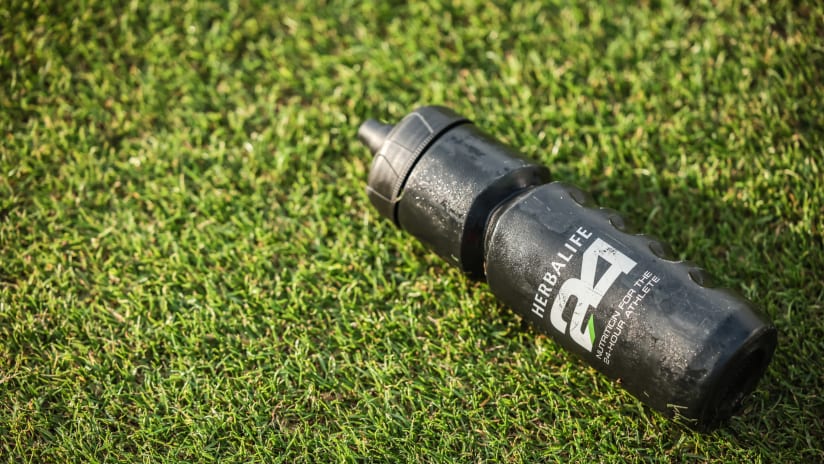Herbalife is the sports nutrition and presenting partner for the LA Galaxy. Herbalife Dietitians work closely with the LA Galaxy technical staff to make sure we are maximizing their nutrition to support performance goals.
Continuing with our female athlete nutrition series, in this article I will cover nutrition considerations for bones, tendons, and ligaments.
Bone health1-4
Female athletes of all ages need healthy bones in order to prevent bone injuries in the short term and osteopenia/osteoporosis in the long term. Low energy availability can lead to poor bone health, as hormonal production is altered and there are typically fewer bone-building nutrients present in the body when overall calories are restricted. Female weight-bearing, distance, and endurance athletes with low energy availability also tend to have lower bone mineral density and overall weaker bones, leaving them more prone to bone injuries.
Balanced estrogen levels are associated with higher bone density. When estrogen levels drop in menopause, bone mineral density typically declines relatively quickly as well, which is a major root cause of osteoporosis development in aging women. Female athletes with poor nutritional status are more likely to have menstrual irregularities tied to lower levels of estrogen production. This association explains why female athletes with amenorrhea have an increased risk of stress fractures despite regular training with weight-bearing exercises.
To maintain healthy bones and prevent fractures, female athletes should focus on consuming enough energy (to prevent low energy availability and its downstream hormonal impacts), along with enough nutrients, especially calcium, vitamin D, and magnesium. Other nutrients important for bone health include phosphorus, potassium, vitamin A, zinc, vitamin C, and vitamin K.
Tendon and ligament health5-10
Did you know that female athletes - especially those in soccer, gymnastics, lacrosse, and basketball - have a higher risk of non-contact ACL injuries than their male counterparts? A 2021 systematic review and meta-regression analysis found that female team sport athletes aged 16 years or older have a 2.15 times higher rate of ACL injuries than male athletes. This increased risk may be partially due to anatomical differences and influenced by hormonal variations.
A 2017 systematic review and meta-analysis found that ACL laxity and injury risk are especially increased during the ovulatory phase of the menstrual cycle, although the overall level of this evidence is low. More research is needed to better elucidate this relationship and to unravel the impact it may have on female athletes.
Collagen is one of the key components of tendons and ligaments. Consuming 5-15 grams of collagen peptides an hour prior to training/games may help give your body an extra protective boost to prevent and recover from injury through improving joint function, increasing length of exertion, and leading to reductions in joint pain. These benefits have been seen in athletes who supplement collagen peptides/hydrolysate or undenatured type II collagen for a minimum of 3 months.
For female athletes who track their cycle, it is crucial to know that ligaments are looser on the days leading up to ovulation due to higher estrogen levels, leaving your joints potentially more prone to injury. On these days, focusing on collagen peptides and vitamin C intake prior to training may be especially beneficial.
Other important nutrients to focus on during pre-ovulatory days include protein, antioxidant vitamins A, C, and E, calcium, vitamin D, manganese, zinc, and copper.
In the next article, I will discuss the most common micronutrient deficiencies that are seen in female athletes, outlining how those deficiencies can negatively impact athletic performance.
References
1. Dipla K, Kraemer RR, Constantini NW, Hackney AC. Relative energy deficiency in sports (RED-S): elucidation of endocrine changes affecting the health of males and females. Hormones (Athens). 2021;20(1):35-47. doi:10.1007/s42000-020-00214-w
2. Hutson MJ, O'Donnell E, Brooke-Wavell K, Sale C, Blagrove RC. Effects of Low Energy Availability on Bone Health in Endurance Athletes and High-Impact Exercise as A Potential Countermeasure: A Narrative Review. Sports Med. 2021;51(3):391-403. doi:10.1007/s40279-020-01396-4
3. Väänänen HK, Härkönen PL. Estrogen and bone metabolism. Maturitas. 1996;23 Suppl:S65-S69. doi:10.1016/0378-5122(96)01015-8
4. Palacios C. The role of nutrients in bone health, from A to Z. Crit Rev Food Sci Nutr. 2006;46(8):621-628. doi:10.1080/10408390500466174
5. Larwa J, Stoy C, Chafetz RS, Boniello M, Franklin C. Stiff Landings, Core Stability, and Dynamic Knee Valgus: A Systematic Review on Documented Anterior Cruciate Ligament Ruptures in Male and Female Athletes. Int J Environ Res Public Health. 2021;18(7):3826. Published 2021 Apr 6. doi:10.3390/ijerph18073826
6. Agel J, Rockwood T, Klossner D. Collegiate ACL Injury Rates Across 15 Sports: National Collegiate Athletic Association Injury Surveillance System Data Update (2004-2005 Through 2012-2013). Clin J Sport Med. 2016;26(6):518-523. doi:10.1097/JSM.0000000000000290
7. Zech A, Hollander K, Junge A, et al. Sex differences in injury rates in team-sport athletes: A systematic review and meta-regression analysis. J Sport Health Sci. 2022;11(1):104-114. doi:10.1016/j.jshs.2021.04.003
8. Herzberg SD, Motu'apuaka ML, Lambert W, Fu R, Brady J, Guise JM. The effect of menstrual cycle and contraceptives on ACL injuries and laxity: A systematic review and meta-analysis. Orthop J Sports Med. 2017;5(7):2325967117718781. Published 2017 Jul 21. doi:10.1177/2325967117718781
9. Khatri M, Naughton RJ, Clifford T, Harper LD, Corr L. The effects of collagen peptide supplementation on body composition, collagen synthesis, and recovery from joint injury and exercise: A systematic review. Amino Acids. 2021;53(10):1493-1506. doi:10.1007/s00726-021-03072-x
10. Curtis L. Nutritional research may be useful in treating tendon injuries. Nutrition. 2016;32(6):617-619. doi:10.1016/j.nut.2015.12.039




